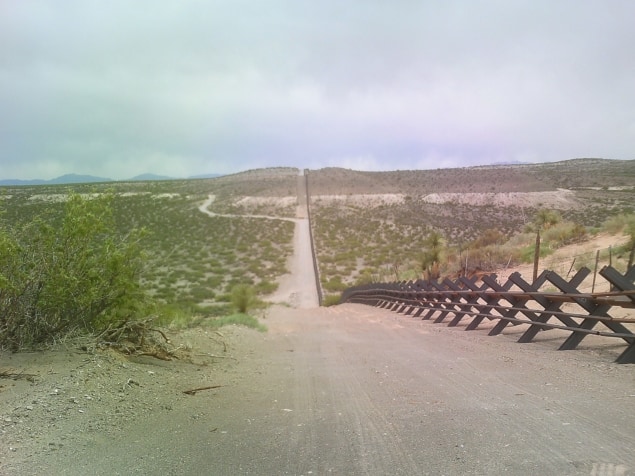
Each year an estimated half a million people slip illegally over the Mexico-US border. Trying to stop them are over 20,000 Border Patrol agents, guarding a more than 3000 km stretch of arid, semi-arid and desert landscape. The human activity along this narrow strip of land changes the environment, according to a recent study.
Shrubs and woody plants have encroached landscapes in the US Southwest border region for the last 150 years. In some areas brushy and woody plants have taken over and it is unlikely that the original grassland will ever regenerate — once mesquite shrubs march in there is no tempting the yucca or ocotillo cactus back. Without a doubt climate change and over-grazing have played a role. The dry climate and limited water resources make the region sensitive to drought and warmth. However, anecdotal evidence suggested that illegal border crossings had also had a substantial impact.
To test this theory Haoying Wang from New Mexico Tech, US, integrated large-scale remote sensing data with socio-economic data and modelled the trends in vegetation cover change and impact of human disturbance from 2008 to 2017. The remote sensing data reveal a large increase in shrubland and barren areas during this short period, and a significant decrease in grassland and pasture.
Gathering accurate data on illegal crossings is difficult but border patrol staffing figures and apprehensions act as a reasonable proxy. By combining these two datasets Wang confirmed that illegal crossings do significantly damage the vegetation and ecosystem in the border area, and that increased border patrol activity also causes serious damage.
Wang’s model showed that within a 3-mile buffer of the border a 10% increase in illegal border crossings would lead the vegetation cover to decline by an additional 13% above the expected annual background decline. And a 10% increase in border patrol staffing would bring an extra 135% vegetation cover decline relative to the annual background.
However, Wang cautions that these two scenarios aren’t directly comparable as they are not equally likely and therefore follow different statistical distributions.
Sometimes policy change, such as tightening up security at border crossings, can result in a displacement effect and lead to more illegal crossings in remote regions.
“Those remote routes usually go through areas with rich wilderness or protected wilderness areas like the Big Bend National Park and the Organ Pipe Cactus National Monument,” says Wang, who published his findings in Environmental Research Letters (ERL).
One of the reasons that increased border patrol activity is so damaging is the use of heavy-duty vehicles and the necessity to travel off-road.
“In a semi-arid/arid environment, the ecosystem is very weak,” says Wang. “When you drive on a route often enough, it becomes a new road. If the road does not get proper maintenance the erosion will expand around. Eventually, it is hard for vegetation cover to come back.”
Losing the native vegetation has a host of unwelcome consequences. For example, native grasslands absorb more carbon dioxide than barren areas or shrubland. In addition, native vegetation helps to bind the soil, absorb rainwater into underground aquifers, prevent flooding and soil erosion, support a diverse ecosystem and, if managed properly, provide sustainable livestock feed.
By understanding the impacts of illegal crossing and border security activity, and identifying the hotspots for vegetation change, Wang believes it will be possible to stem some of the damage. He is currently in discussion with the US National Park Service to see what kind of policymaking and public communication measures might be used to protect these fragile lands.



